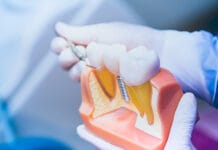While digging in the abyss of research studies, I fell across information about a potential new antibiotic that may have a chance to be utilized in the treatment of periodontal disease without drug resistance and would spare beneficial bacteria.
For many years, the standard of care for treating periodontal disease included scaling and root planing. We may sometimes adjunctively use laser, ozone, or a regimen of probiotics. Certain periodontal pathogens can be resistant to therapy, and the need for “more effective” antibiotic treatment is in the best interest of the patient.1
Dentistry’s hands are tied, however. Our patients may need antibiotics in some cases, but the warning to us has been strong. As a profession, we should be extremely judicious in prescribing them. The term used now is “antibiotic stewardship.” Even when we deem antibiotics necessary, our choices are limited.
Clindamycin, tetracycline, and amoxicillin are all broad-spectrum antibiotics that are useful when wiping out bad bugs, but they, unfortunately, take out the good ones too. This lends itself to reinfection because the good guys are gone, and now the bad ones don’t have to compete with resident microflora.
Clindamycin is often used to treat tooth abscesses when anaerobes are suspected. Clindamycin is highly associated with C. difficile colitis. What about metronidazole, you ask? While it does inhibit anaerobic bacteria, it has problematic side effects such as neurotoxicity, peripheral neuropathy, nausea, and colitis. The FDA requires a black box warning for metronidazole.2 With those caveats, patient compliance, as you can imagine, may be an issue.3
As good as it is, metronidazole is usually used in combination with amoxicillin, then making the combination broad spectrum. This therapy eliminates both pathogenic and beneficial bacteria.
Periodontal pathogens are a beast to treat and exhibit resistance to some antibiotics. In research, doxycycline was resistant in 55% of patients, amoxicillin in 43.3%, metronidazole in 30.3%, and clindamycin in 26.5%.4 There needs to be a more pathogen-selective adjunctive therapy that targets the harmful pathogens. Historically, there has been a subgingival treatment of tetracycline and one with chlorhexidine used in combination with SRP. Metronidazole also has a 25% gel used inside pockets and unfortunately didn’t yield results at decreasing probing over SRP alone.5
Resistance
C-diff (also known as Clostridioides difficile or C. difficile) hit the news in the early 2000s. It’s considered an infection (colitis) and can cause dehydration, sepsis, and death in some cases. It is one of the most commonly acquired hospital infections in the United States. The growth of C-diff is largely attributed to clindamycin and the overuse of ciprofloxacin and related antibiotics.
According to the CDC, 14,000 Americans die every year from C-diff infections as well as over 330,000 hospitalizations.6 About one in six patients who get C-diff will get it again within the following two to eight weeks. This often occurs in patients with a weakened immune system or a recent hospital stay who have been taking antibiotics. The treatment crazily enough is another antibiotic such as vancomycin or fidaxomicin. To combat the recurrence of C-diff, probiotics are often recommended and generally include Lactobacillus and Bifidobacteria species.
In 2002, nitazoxanide (NTZ) was approved in the United States as an antiparasitic therapy for diarrhea and enteritis-inflammation of the small intestine. NTZ has an inhibitory action against both anaerobic gram-positive and gram-negative bacteria and has been confirmed in animal studies and clinical trials as a treatment for C-diff.7
Nitazoxanide and its Derivative, Amixicile
NTZ has a counterpart, amixicile (AMIX). NTZ is an antiprotozoal, antiviral medicine that treats infections caused by protozoa such as giardia, Trichomonas vaginalis, and cryptosporidium. Romark, a pharmaceutical company, has two FDA-approved products in the United States. Alinia helps treat diarrhea caused by cryptosporidium parvum and giardia. They are currently doing a clinical trial for an extended-release NT-300 in the prevention and treatment of COVID-19. However, there are problems with NTZ, such as poor absorption, drug metabolism, and some off-target activities.
Dentistry can take notice of NTZ due to its effects on anaerobic bacteria. In Egypt, a clinical trial of 40 patients with a subgingival hydrogel of 0.01% NTZ administered twice in SRP patients ‒ one-week post-op and then another week follow-up. Their results showed a significantly greater reduction in probing, bleeding, and MMP-8 levels as compared to SRP alone.8
AMIX appears to have some advantages over NTZ, including low toxicity, water-solubility, eradicates C-diff, and prevents relapse in animal models. The benefits of AMIX are the improved pharmacokinetics (readily absorbed and absence of drug metabolism) and is not excreted in feces, thus no effect on the gut microflora. Amixicile does not harm beneficial probiotic microflora.
How they work? AMIX and NTZ inhibit an important enzyme pyruvate: ferredoxin oxidoreductase (PFOR). PFOR is present in anaerobic pathogenic bacteria, and AMIX can inhibit their growth.9 There have been no reports of drug resistance in the clinical use of NTZ, which might be an indicator of the potential longevity of this class of antimicrobials and the unique nature of mechanistic action.10
In layman’s terms, NTZ is a broad-spectrum antiparasitic that exhibits antiviral and anticancer activities. For periodontal disease, though, we need an oral therapeutic of a more narrow spectrum.
Amixicile and Periodontal Disease
Amixicile specifically inhibits the growth of anaerobic bacteria that include periodontal pathogens. Chronic oral anaerobic infections in gingivitis and periodontitis are hard to get rid of, as we well know. Between drug resistance and dysbiosis, the challenge of finding an antibiotic with no adverse effects would be welcomed. This antimicrobial has the potential to reverse and prevent the outgrowth of anaerobic pathogens. Given its lack of side effects, it could also be the first preventive measure for patients at risk for the development of periodontal disease.
Research done by Warren et al. and Hoffman et al. on amixicile had validation in animal models for the treatment of C-diff colitis and Helicobacter pylori infection, respectively.11,12 However, validation in an animal model for the treatment of periodontal disease is difficult. The oral microbiome is different in rodents than in humans.13 In an ex vivo microbiome that came from gingival pockets of humans having advanced periodontal disease, the researchers found amixicile inhibits the growth of anaerobic bacteria that include periodontal pathogens. More recently, Gui et al. reported that amixicile showed efficacy in the treatment of periodontal disease in the non-human primate (Macca mulatta) model.14
In 2017 research showed that amixicile inhibited the growth of Porphyromonas gingivalis, Prevotella intermedia, and Fusobacterium nucleatum similar to metronidazole.15Additionally, amixicile is the first selective therapeutic agent active against bacteria internalized by host cells. Amixicile targets the cofactor of PFOR rather than the enzyme itself, which then reduces the risk of antibiotic resistance by mutation. Other research found that AMIX is active against several oral treponeme species, including a red complex pathogen, Treponema denticola.16
Development Distracted by Veterinary Use?
Where can we find amixicile? It was licensed last year to a pharma company, Velovia, to be developed for veterinary use. As a dog lover, I think this is terrific. Treating periodontal disease in dogs and cats and GI issues is important. While that is wonderful, are we going to get a handle on animal perio before humans? The license was for veterinary use, which does not require phase III human trials where costs can exceed a half a billion dollars.
Amixicile has made it through partial pre-IND (investigative new drug) studies with the help of the NIH, but further drug tolerance and safety/tox studies in animals remain to be completed. These more expensive studies would require a big benefactor. It takes 20 years to get an antibiotic through research and human clinical trials with the cost of over $1 billion.
How does anyone recoup that money when so many antibiotics are generic prescriptions? There is still a chance for amixicile to be licensed for human development, but it lies in the hands of groups with the wealth of Bill and Melinda Gates or Jeff Bezos.
Author’s note: I must share something that is important to me, and it’s an important lesson I believe we all need. I got stuck writing this article because I couldn’t figure out the method of action of this drug. As you well know, I am not a microbiologist ‒ far from it ‒ and it is sometimes difficult to distill what I need to for the reader if I don’t clearly understand.
I reached out to the infectious disease researcher and author of most of the amixicile studies, Dr. Paul S. Hoffman. He answered my email, was gracious, kind, and spoke to me for an hour on the phone. Additionally, he mercifully read my article and made some edits. We got to know each other a bit, and, as usual, I am awed by the smart ones. His CV is extensive, his knowledge enormous, and his generosity soul-filling.
He mentioned he had taught microbiology and immunology to dental hygienists and dental students. Thank you, Dr. Hoffman. People who make huge changes in health care that allow me a conversation and education always leave me gobsmacked. When someone asks us in dentistry to connect for advice or counsel, make the time; we are not that busy, and it may make a big difference in another person’s life.
Now Check Out the Peer-Reviewed, Self-Study CE Courses from Today’s RDH!
Listen to the Today’s RDH Dental Hygiene Podcast Below:
References
- Burmølle, M., Webb, J.S., Rao, D., et al. Enhanced biofilm formation and increased resistance to antimicrobial agents and bacterial invasion are caused by synergistic interactions in multispecies biofilms. Appl Environ Microbiol. 2006; 72(6): 3916-3923. doi:10.1128/AEM.03022-05. https://pubmed.ncbi.nlm.nih.gov/16751497/
- Dingsdag, S.A., Hunter, N. Metronidazole: an update on metabolism, structure-cytotoxicity and resistance mechanisms. J Antimicrob Chemother. 2018; 73(2): 265-279. doi:10.1093/jac/dkx351. https://pubmed.ncbi.nlm.nih.gov/29077920/
- Ohnishi, K., Sakamoto, N., Kobayashi, K., et al. Subjective adverse reactions to metronidazole in patients with amebiasis. Parasitol Int. 2014; 63(5): 698-700. doi:10.1016/j.parint.2014.05.006. https://pubmed.ncbi.nlm.nih.gov/24929036/
- Rams, T.E., Degener, J.E., van Winkelhoff, A.J. Antibiotic resistance in human chronic periodontitis microbiota. J Periodontol. 2014; 85(1): 160-169. doi:10.1902/jop.2013.130142. https://pubmed.ncbi.nlm.nih.gov/23688097/
- Leiknes, T., Leknes, K.N., Böe, O.E., et al. Topical use of a metronidazole gel in the treatment of sites with symptoms of recurring chronic inflammation. J Periodontol. 2007; 78(8): 1538-1544. doi:10.1902/jop.2007.060501. https://pubmed.ncbi.nlm.nih.gov/17668973/
- C. diff (Clostridioides difficile). (2021, July 12). Centers for Disease Control and Prevention. https://www.cdc.gov/cdiff/index.html
- Rossignol, J.F. Nitazoxanide: a first-in-class broad-spectrum antiviral agent. Antiviral Res. 2014; 110: 94-103. doi:10.1016/j.antiviral.2014.07.014. https://pubmed.ncbi.nlm.nih.gov/25108173/
- Taalab, M., Makled, S., El-Khordagui, L.K., et al. Nitazoxanide as a new treatment modality adjunctive to non-surgical treatment of state II periodontitis: Clinical and biochemical evaluation. Egyptian Dental Journal. 2022; 68: 457-466. https://www.researchgate.net/publication/359160115
- Kennedy, A.J., Bruce, A.M., Gineste, C., et al. Synthesis and Antimicrobial Evaluation of Amixicile-Based Inhibitors of the Pyruvate-Ferredoxin Oxidoreductases of Anaerobic Bacteria and Epsilonproteobacteria. Antimicrob Agents Chemother. 2016; 60(7): 3980-3987. doi:10.1128/AAC.00670-16. https://pubmed.ncbi.nlm.nih.gov/27090174/
- Shakya, A., Bhat, H.R., Ghosh, S.K. Update on Nitazoxanide: A Multifunctional Chemotherapeutic Agent. Curr Drug Discov Technol. 2018; 15(3): 201-213. doi:10.2174/1570163814666170727130003. https://pubmed.ncbi.nlm.nih.gov/28748751/
- Warren, C.A., van Opstal, E., Ballard, T.E., et al. Amixicile, a novel inhibitor of pyruvate: ferredoxin oxidoreductase, shows efficacy against Clostridium difficile in a mouse infection model. Antimicrob Agents Chemother. 2012; 56(8): 4103-4111. doi:10.1128/AAC.00360-12. https://pubmed.ncbi.nlm.nih.gov/22585229/
- Hoffman, P.S., Bruce, A.M., Olekhnovich, I., et al. Preclinical studies of amixicile, a systemic therapeutic developed for treatment of Clostridium difficile infections that also shows efficacy against Helicobacter pylori. Antimicrob Agents Chemother. 2014; 58(8): 4703-4712. doi:10.1128/AAC.03112-14. https://pubmed.ncbi.nlm.nih.gov/24890599/
- Gui, Q., Ramsey, K.W., Hoffman, P.S., Lewis, J.P. Amixicile depletes the ex vivo periodontal microbiome of anaerobic bacteria. Journal of Oral Biosciences. 2020; 62(2): 195-204. https://doi.org/10.1016/j.job.2020.03.004
- Gui, Q., Lyons, D.J., Deeb, J.G., et al. Non-human Primate Macaca mulattaas an Animal Model for Testing Efficacy of Amixicile as a Targeted Anti-periodontitis Therapy. Front Oral Health. 2021; 2: 752929. doi:10.3389/froh.2021.752929. https://pubmed.ncbi.nlm.nih.gov/35048063/
- Hutcherson, J.A., Sinclair, K.M., Belvin, B.R., et al. Amixicile, a novel strategy for targeting oral anaerobic pathogens. Sci Rep. 2017; 7(1):10474. doi:10.1038/s41598-017-09616-0. https://pubmed.ncbi.nlm.nih.gov/28874750/
- Reed, L.A., O’Bier, N.S., Oliver, L.D. Jr., et al. Antimicrobial activity of amixicile against Treponema denticola and other oral spirochetes associated with periodontal disease. J Periodontol. 2018; 89(12): 1467-1474. doi:10.1002/JPER.17-0185. https://pubmed.ncbi.nlm.nih.gov/29958324/












